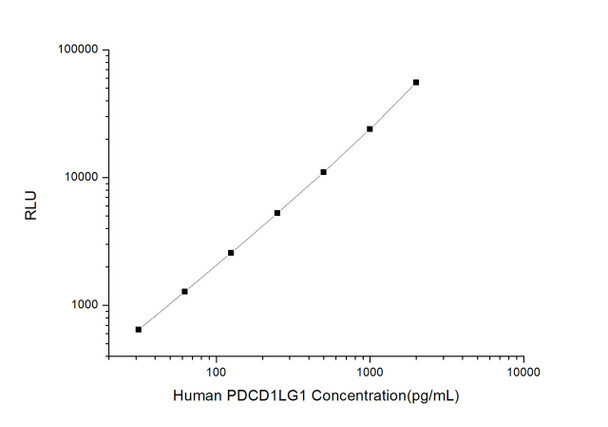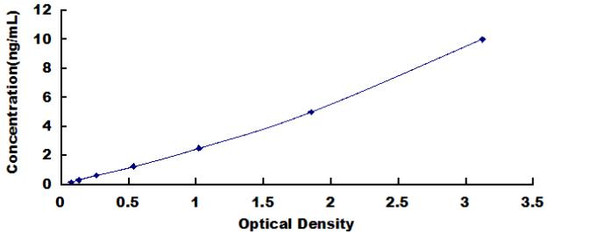Human Immunology ELISA Kits 1
Human PDCD1LG1 (Programmed Cell Death Protein 1 Ligand 1) CLIA Kit (HUES00877)
- SKU:
- HUES00877
- Product Type:
- ELISA Kit
- ELISA Type:
- CLIA Kit
- Size:
- 96 Assays
- Sensitivity:
- 18.75pg/mL
- Range:
- 31.25-2000pg/mL
- ELISA Type:
- Sandwich
- Synonyms:
- CD274, B7-H1, PD-L1, PDCD1L1, PDL1, B7 homolog 1
- Reactivity:
- Human
- Sample Type:
- Serum, plasma and other biological fluids
- Research Area:
- Immunology
Description
| Assay type: | Sandwich |
| Format: | 96T |
| Assay time: | 4.5h |
| Reactivity: | Human |
| Detection method: | Chemiluminescence |
| Detection range: | 31.25-2000 pg/mL |
| Sensitivity: | 18.75 pg/mL |
| Sample volume: | 100µL |
| Sample type: | Serum, plasma and other biological fluids |
| Repeatability: | CV < 15% |
| Specificity: | This kit recognizes Human PDCD1LG1 in samples. No significant cross-reactivity or interference between Human PDCD1LG1 and analogues was observed. |
This kit uses Sandwich-CLIA as the method. The micro CLIA plate provided in this kit has been pre-coated with an antibody specific to Human PDCD1LG1. Standards or samples are added to the appropriate micro CLIA plate wells and combined with the specific antibody. Then a biotinylated detection antibody specific for Human PDCD1LG1 and Avidin-Horseradish Peroxidase (HRP) conjugate are added to each micro plate well successively and incubated. Free components are washed away. The substrate solution is added to each well. Only those wells that contain Human PDCD1LG1, biotinylated detection antibody and Avidin-HRP conjugate will appear fluorescence. The Relative light unit (RLU) value is measured spectrophotometrically by the Chemiluminescence immunoassay analyzer. The RLU value is positively associated with the concentration of Human PDCD1LG1. The concentration of Human PDCD1LG1 in the samples can be calculated by comparing the RLU of the samples to the standard curve.
| UniProt Protein Function: | CD274: Involved in the costimulatory signal, essential for T- cell proliferation and production of IL10 and IFNG, in an IL2- dependent and a PDCD1-independent manner. Interaction with PDCD1 inhibits T-cell proliferation and cytokine production. Belongs to the immunoglobulin superfamily. BTN/MOG family. 3 isoforms of the human protein are produced by alternative splicing. |
| UniProt Protein Details: | Protein type:Membrane protein, integral Chromosomal Location of Human Ortholog: 9p24. 1 Cellular Component: plasma membrane Molecular Function:protein binding Biological Process: cell surface receptor linked signal transduction; immune response; negative regulation of activated T cell proliferation; negative regulation of interferon-gamma production; negative regulation of interleukin-10 production; positive regulation of T cell proliferation; regulation of activated T cell proliferation; response to cytokine stimulus; signal transduction; T cell costimulation |
| NCBI Summary: | This gene encodes an immune inhibitory receptor ligand that is expressed by hematopoietic and non-hematopoietic cells, such as T cells and B cells and various types of tumor cells. The encoded protein is a type I transmembrane protein that has immunoglobulin V-like and C-like domains. Interaction of this ligand with its receptor inhibits T-cell activation and cytokine production. During infection or inflammation of normal tissue, this interaction is important for preventing autoimmunity by maintaining homeostasis of the immune response. In tumor microenvironments, this interaction provides an immune escape for tumor cells through cytotoxic T-cell inactivation. Expression of this gene in tumor cells is considered to be prognostic in many types of human malignancies, including colon cancer and renal cell carcinoma. Alternative splicing results in multiple transcript variants. [provided by RefSeq, Sep 2015] |
| UniProt Code: | Q9NZQ7 |
| NCBI GenInfo Identifier: | 83287884 |
| NCBI Gene ID: | 29126 |
| NCBI Accession: | Q9NZQ7. 1 |
| UniProt Secondary Accession: | Q9NZQ7,Q14CJ2, Q2V8D5, Q66RK1, Q6WEX4, Q9NUZ5, B2RBA2 B4DU27, |
| UniProt Related Accession: | Q9NZQ7 |
| Molecular Weight: | 20,454 Da |
| NCBI Full Name: | Programmed cell death 1 ligand 1 |
| NCBI Synonym Full Names: | CD274 molecule |
| NCBI Official Symbol: | CD274 |
| NCBI Official Synonym Symbols: | B7-H; B7H1; PDL1; PD-L1; PDCD1L1; PDCD1LG1 |
| NCBI Protein Information: | programmed cell death 1 ligand 1 |
| UniProt Protein Name: | Programmed cell death 1 ligand 1 |
| UniProt Synonym Protein Names: | B7 homolog 1; B7-H1; CD_antigen: CD274 |
| UniProt Gene Name: | CD274 |
As the RLU values of the standard curve may vary according to the conditions of the actual assay performance (e. g. operator, pipetting technique, washing technique or temperature effects), the operator should establish a standard curve for each test. Typical standard curve and data is provided below for reference only.
| Concentration (pg/mL) | RLU | Average | Corrected |
| 2000 | 52839 58603 | 55721 | 55693 |
| 1000 | 22920 25028 | 23974 | 23946 |
| 500 | 11864 10200 | 11032 | 11004 |
| 250 | 5165 5423 | 5294 | 5266 |
| 125 | 2665 2551 | 2608 | 2580 |
| 62.5 | 1364 1258 | 1311 | 1283 |
| 31.25 | 657 691 | 674 | 646 |
| 0 | 28 28 | 28 | -- |
Precision
Intra-assay Precision (Precision within an assay): 3 samples with low, mid range and high level Human PDCD1LG1 were tested 20 times on one plate, respectively.
Inter-assay Precision (Precision between assays): 3 samples with low, mid range and high level Human PDCD1LG1 were tested on 3 different plates, 20 replicates in each plate.
| Intra-assay Precision | Inter-assay Precision | |||||
| Sample | 1 | 2 | 3 | 1 | 2 | 3 |
| n | 20 | 20 | 20 | 20 | 20 | 20 |
| Mean (pg/mL) | 104.78 | 231.27 | 957.43 | 95.27 | 212.79 | 943.65 |
| Standard deviation | 10.08 | 20.31 | 109.91 | 12.28 | 18.11 | 63.22 |
| C V (%) | 9.62 | 8.78 | 11.48 | 12.89 | 8.51 | 6.70 |
Recovery
The recovery of Human PDCD1LG1 spiked at three different levels in samples throughout the range of the assay was evaluated in various matrices.
| Sample Type | Range (%) | Average Recovery (%) |
| Serum (n=5) | 100-111 | 106 |
| EDTA plasma (n=5) | 88-101 | 94 |
| Cell culture media (n=5) | 97-112 | 103 |
Linearity
Samples were spiked with high concentrations of Human PDCD1LG1 and diluted with Reference Standard & Sample Diluent to produce samples with values within the range of the assay.
| Serum (n=5) | EDTA plasma (n=5) | Cell culture media (n=5) | ||
| 1:2 | Range (%) | 92-106 | 99-113 | 85-95 |
| Average (%) | 98 | 107 | 90 | |
| 1:4 | Range (%) | 100-118 | 101-115 | 96-109 |
| Average (%) | 108 | 109 | 103 | |
| 1:8 | Range (%) | 102-116 | 99-114 | 87-98 |
| Average (%) | 110 | 107 | 92 | |
| 1:16 | Range (%) | 98-110 | 92-107 | 83-96 |
| Average (%) | 104 | 99 | 90 |
An unopened kit can be stored at 4°C for 1 month. If the kit is not used within 1 month, store the items separately according to the following conditions once the kit is received.
| Item | Specifications | Storage |
| Micro CLIA Plate(Dismountable) | 8 wells ×12 strips | -20°C, 6 months |
| Reference Standard | 2 vials | |
| Concentrated Biotinylated Detection Ab (100×) | 1 vial, 120 µL | |
| Concentrated HRP Conjugate (100×) | 1 vial, 120 µL | -20°C(shading light), 6 months |
| Reference Standard & Sample Diluent | 1 vial, 20 mL | 4°C, 6 months |
| Biotinylated Detection Ab Diluent | 1 vial, 14 mL | |
| HRP Conjugate Diluent | 1 vial, 14 mL | |
| Concentrated Wash Buffer (25×) | 1 vial, 30 mL | |
| Substrate Reagent A | 1 vial, 5 mL | 4°C (shading light) |
| Substrate Reagent B | 1 vial, 5 mL | 4°C (shading light) |
| Plate Sealer | 5 pieces | |
| Product Description | 1 copy | |
| Certificate of Analysis | 1 copy |
- Set standard, test sample and control (zero) wells on the pre-coated plate and record theirpositions. It is recommended to measure each standard and sample in duplicate. Note: addall solutions to the bottom of the plate wells while avoiding contact with the well walls. Ensuresolutions do not foam when adding to the wells.
- Aliquot 100µl of standard solutions into the standard wells.
- Add 100µl of Sample / Standard dilution buffer into the control (zero) well.
- Add 100µl of properly diluted sample (serum, plasma, tissue homogenates and otherbiological fluids. ) into test sample wells.
- Cover the plate with the sealer provided in the kit and incubate for 90 min at 37°C.
- Aspirate the liquid from each well, do not wash. Immediately add 100µL of BiotinylatedDetection Ab working solution to each well. Cover the plate with a plate seal and gently mix. Incubate for 1 hour at 37°C.
- Aspirate or decant the solution from the plate and add 350µL of wash buffer to each welland incubate for 1-2 minutes at room temperature. Aspirate the solution from each well andclap the plate on absorbent filter paper to dry. Repeat this process 3 times. Note: a microplatewasher can be used in this step and other wash steps.
- Add 100µL of HRP Conjugate working solution to each well. Cover with a plate seal andincubate for 30 min at 37°C.
- Aspirate or decant the solution from each well. Repeat the wash process for five times asconducted in step 7.
- Add 100µL of Substrate mixture solution to each well. Cover with a new plate seal andincubate for no more than 5 min at 37°C. Protect the plate from light.
- Determine the RLU value of each well immediately.






